Well that about does it for this field season. It was one of the strangest ones on record for those that have been doing this for decades – this was the NEAq team’s 34th year in the Bay! We ended the season having no sightings on board Selkie. In fact, this was the first time Grace has been to Fundy and not seen a single right whale, and she has been coming here for 20 years…but negative data is still data, as they say, and this year proves that despite all that we do know we still have a lot to learn. It will be very interesting to see where/when the whales show up next!
Susan Parks
Eubalaena, where art thou?
Seals and sharks
Puffins and porpoise
Minkes and fin whales
They hide not from us
But where are you, right whale?
It is you that we seek
Who numbers so few
Whose future seems bleak
Eubalaena we’ve watched you
And followed you close
All whales need saviors
But you need us most
For thirty-four summers
Why, even this past
You have gathered in Fundy
You have gathered en masse
But this year is different
This year is odd
There is scant food to be found
Scarcely one copepod
This year you’re gone
You found a new place
And we cannot find you
You left us no trace
Eubalaena, where art thou?
If you are not here
No one can find you
Our hearts fill with fear
Eubalaena, where art thou?
Come back to the Bay
For we cannot protect you
Now that you’ve gone away
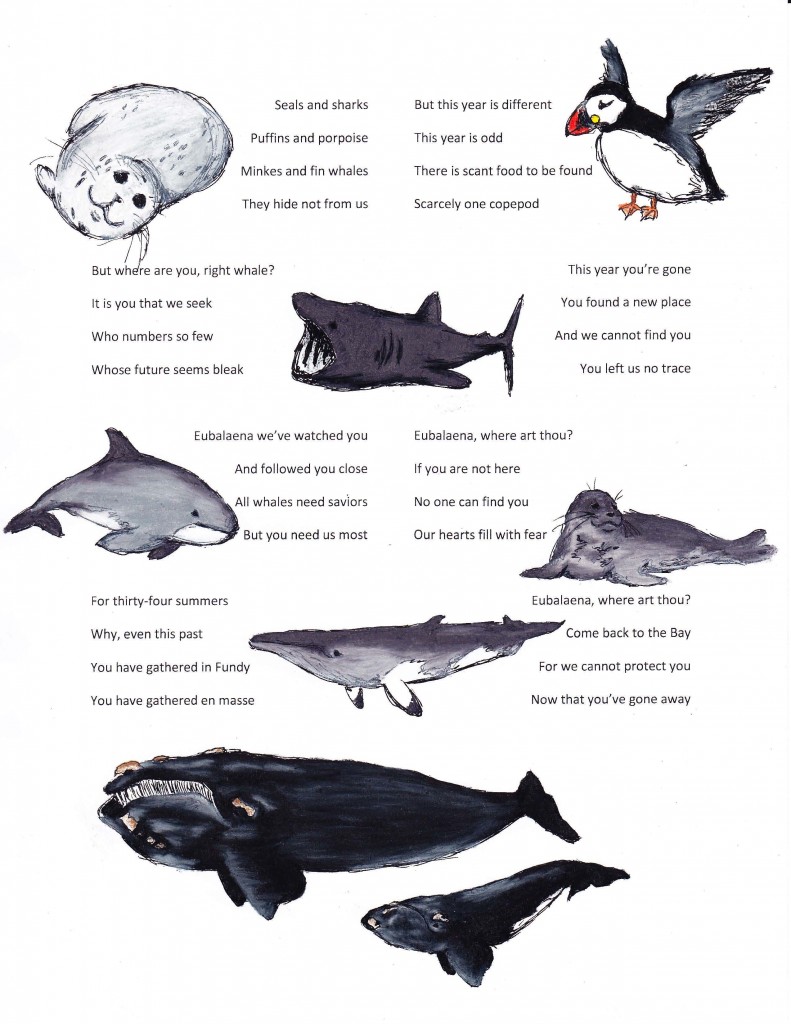
Not the *right* whales
When looking at the weather forecast last night as we always do, it looked like today might be good for at least a half day out on the water. The winds were light in the morning and would blow 10-15 later in the day. Since we haven’t had much of an opportunity to go out this season, we decided to go for it. When checking the weather again this morning as we always do, the forecast had changed. For once, though, it changed in our favor. It was now going to blow light winds all day with calm seas and not pick up until the evening. Could it be? Could we get a full day in?!
Nope. The channel was a bit choppy, but that doesn’t necessarily indicate what the Bay is doing. When we got out of the channel however, we immediately noticed it was not smooth flat seas with light winds. It was about a sea state 2 already, which is definitely workable but not the calm state we were expecting/hoping to see (see our previous blog post, A Lesson on Sea State, to get an idea of what the sea states look like). Will soon spotted some blows, and even though they didn’t look like typical right whale blows, we are always willing to investigate anything and everything. Especially when there are so few whales around, during this season for example! When we made it over to the whales we quickly realized they were three humpback whales, resting at the surface.
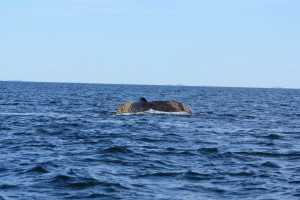
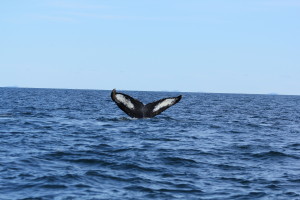
Shortly after, only about half an hour from these photos, we were in a sea state 3 and it wasn’t even 11 o’clock! Grace called up the Nereid to see what they were experiencing farther out in the Bay and they also had quite a nasty sea state. They have the ability to check the weather on their boat and the forecast had indeed changed. Now they were calling for 15 knot winds in the afternoon going to 20 knots later on this evening. That’s a far cry from light winds and way too windy for us to work comfortably and safely on our exposed little Selkie.
We decided to call it a day after only 3 hours out. We cast the CTD for good measure and headed home. By that time it had already turned into a sea state 4…we had a bumpy ride back, albeit a short one thankfully. We have a windy few days ahead of us so we won’t be back out into the Bay for a little while. Hopefully next time mother nature behaves a little better and does what the meteorologists think she will!
Perhaps the fog is lifting?
Figuratively, anyway. After a very slow month, as in zero right whales spotted by either team in the Bay, a mom/calf pair has been spotted! Last Wednesday reports came in that there was a mother and her calf in the Lubec Channel. The Nereid crew rushed to the scene, which didn’t take long considering they were so close…

Very few right whales have ever been spotted in this area, and while it is pretty neat to have them so close to shore, it was also pretty nerve-wracking for us. Just past the bridge from Lubec to Campobello there is a lot of lobster/fishing gear in the water which would put them at a high risk for entanglement. Luckily they headed in the opposite direction toward Eastport where they likely (hopefully) headed back out towards more open water. They haven’t been spotted in the area again, and we haven’t had a good day to go out and survey the Bay to check for them. I can only hope they stick around for when we can make it out next. It would be great to finally get some BOF 2013 data! Read more about the Nereid’s experience on the New England Aquarium’s research blog.
Slow start
We finally managed to get out on the water on Monday (as you may recall from last year the weather here is not overly cooperative) but it seems we were not missing much…we saw a couple of minke whales, a bunch of harbor porpoises, and a fin whale. The Nereid (the boat used by the New England Aquarium’s research team) went out as well and they saw a few humpback whales to add to the list of cetaceans in the Bay. But as for the right whales? Conspicuously absent. The Nereid surveyed a good portion of the Bay already this year and the right whales just aren’t here yet. In fact, the New England Aquarium has decided to take a small team offshore to look for right whales in Roseway Basin and Lurcher Shoal, off of the coast of Nova Scotia. They left this morning and will be at sea for 6-10 days. Hopefully they come back with news of lots of whales, preferably headed this way of course!
Our day out wasn’t all disappointment however. Not only did Tricia get to see a whale for the first time, but she got to see a breaching basking shark! Not many people can say that! Unfortunately as soon as I got the camera out he promptly disappeared, but check out the website for our friends at the Shark Identification Network, founded by the Grand Manan Whale and Seabird Research Station, for great photos and information about the sharks in the area.
The weather for the weekend looks promising, so hopefully my next post will be filled with great news about all the mom/calf pairs that have shown up! How is that for optimism?
Getting Settled
Nestled against the Canadian border, at the tippy top of the U.S. East Coast, lies the tiny town of Lubec. This town effectively marks the beginning of the Bay of Fundy, a region known for having the largest tidal range in the world (up to 50 feet in some places!). Lubec’s tides range about 18-22 feet, which is still enough to make a dramatic difference in the landscape every 6 hours or so.

I suppose the rain is good for being productive inside, and it did manage to stop long enough for a light-hearted game of soccer. Today’s weather features pea soup fog along with the rain, so we’re still waiting to go find some moms and calves for our project. Given the bumper crop of calves and our luck in Cape Cod and the Southeast this year, we’re hopeful for some good data from the Fundy feeding grounds!
As a parting note, I’ll leave you with a couple of neat comparisons:

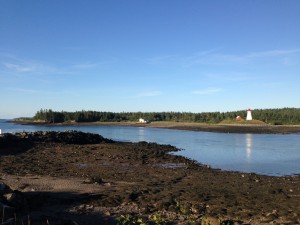
AND…


Spotlight on Steve
Who is Steve, you ask? Well Steve is one of our two true katydid nymphs that we have had here in the lab for a few weeks now. He lives in a nice double-decker cage with his buddy Sampson on the windowsill next to my desk where they can get lots of sun. We give them fresh food every other day and mist them with water to hydrate them. Our goal is to make them happy so that they molt. Steve and Sampson are only nymphs, and won’t make noise until they are adults. It’s actually a lot like growing a plant, except even better because you can interact with them (no offense to plants). And since we aren’t sure which life cycle stage they are in, what they look like after a molt will be a surprise.
Yesterday I was a little concerned for Steve. He wasn’t moving much and seemed sluggish. I know my Steve and I knew he was either getting ready to molt or he wasn’t feeling very well…I hoped for the best and left for the night. I came into the lab this morning and when I checked on “the boys”, what did I see? A fresh molt on the bottom of the cage! It looks kind of like a dead spider, minus two legs. I immediately started searching the cage for Steve and Sampson. The cage may not be large, but boy are those katydids camouflaged well! After a minute of searching I realized I was staring right at Steve…and he was huge!!!
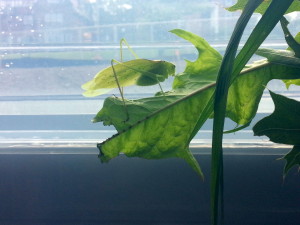
What I also realized was that he was not a true katydid at all…they are an entirely different shape, more short and stout than long like Steve. After a bit of research I discovered that he is actually an oblong winged katydid. Who knew? Surprises all around! Now we wait and hope he starts calling. Let’s hope Sampson joins him in adulthood soon too!
Crickets and Gladiators
Today was a lesson in patience, perseverance, and thermoregulation.
With the temperatures forecasted into the 90s and the knowledge that crickets chirp more often early in the morning, we left the lab early to beat the heat and catch some crickets.
As a quick aside, our grasshoppers happen to belong to the one Genus of grasshoppers that doesn’t use sound. At all. Which means that the first task of today’s collecting adventure was to release them.
We drove to the field where we’ve had good cricket luck, set our grasshoppers free, and started looking. There was only one chirping male near the roadside, and we have suspicions that it was a cricket who had outsmarted us before. Naturally, we were determined to catch him.
“Moby Cricket,” as Dana so aptly named him, apparently had other plans. As before, he advertised his little cricket heart out until we got too close. Then he stopped. It turns out that crickets are very sensitive to vibrations in the air—it’s how they detect predators. And, of course, their first response is to become silent so they’re more difficult to find. Which works. Very, very well. After what seemed like hours of playing this Cat and Mouse game, there were some uprooted plants, a handful of rather colorful words, and three very frustrated field biologists.
Forfeiting this battle to the cricket, we decided to cut our losses and try a different site.
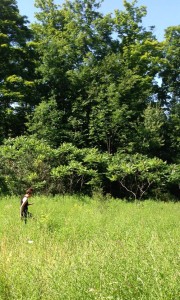
SU’s South campus had been suggested by a few other ecology folks with research fields down there. According to our sources, there should have been crickets by the boatload. Maybe we were in the wrong field, but there was barely a katydid to speak of, much less a cricket.
Desperate to go home with some invertebrate loot, we had a serious brainstorming session.
Crickets prefer locations with water access, so we drove to the pond at Barry Park. In retrospect, a pond was a bit overkill, but we were willing to try anything. Although we struck out cricket-wise, we were fortunate enough to hear a new species of katydid hiding in the cattails near the pond, and these guys were LOUD!
Even though their calls are conspicuous, these new katydids (later identified as Gladiator Meadow Katydids) are sneaky. They hang out on large stems of cattails and other plants, but when they detect something nearby, they not only stop calling but shimmy around to the opposite side of the stem. This resulted in several instances of, “I know he’s six inches from my face, but I can’t see him!”
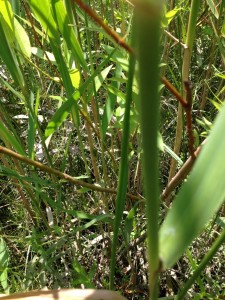
We eventually got the hang of finding them, and after a couple hours of stalking katydids interspersed with shade breaks (the temps were approaching 90 by now, and feeling much hotter), we had 10 of our Gladiators and felt rather pleased with ourselves.
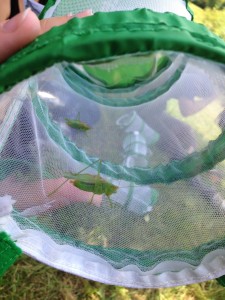
Total bug count as of July 15: 33
1 adult two-striped grasshopper (just in case he does make sounds), 2 Spring field crickets, 2 True katydids, 2 Bush katydids (unk. spp.), 4 Eastern swordbearers (one of which is now an adult and quite pretty!), 12 Roesel’s katydids, 10 Gladiator meadow katydids, Cicadas soon…?
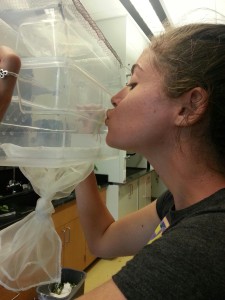
Lessons learned
Yesterday was another long day of bug hunting and cage cleaning, but like every day on this project it was also a day filled with surprises. Jess, Tricia and I headed out early to try to catch some more male crickets and katydids, and maybe even something new along the way. We reached our new spot and were disappointed to hear nothing. No crickets. No katydids. Jess has a hypothesis that they all stop calling when it is cloudy, and it was definitely cloudy. In fact, before too long we had tostop and wait for a bit while it rained. Luckily it only lasted about 10 minutes and we were ready to go.
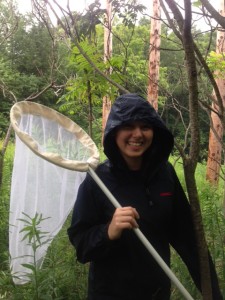
One good thing about the rain? We had much better luck with the crickets after. It seems that maybe crickets come out into the open and move a bit more after the rain, perhaps to find a dry spot. However it works, we found 4 crickets in only a matter of minutes, 2 of which were adult males. After that, we had no more luck in the cricket department, but Jess did find a really cool looking true katydid which was pretty exciting since we haven’t seen any yet. Success!

After being unable to locate even a single katydid, we packed up and headed to our other collecting site, Dr. Starmer’s property. We have had luck there all summer so far and yesterday didn’t disappoint. We managed to get 8 new male Roesel’s katydids and Tricia found another true katydid. Success again!
When we got back to the lab however we realized we were in for quite the challenge. Where were we going to put all these bugs?? After quite a bit of hard thinking, we thought we had it all figured out (thought being the key word). First, we decided to paint the male katydids that we already ran experiments on so that we could house them with the new ones and still keep track of them. We tried just going in with the nail polish, and that failed miserably. We then decided maybe Jess could just hold the legs and we could quickly put a small dab of polish on him. Not our best plan…turns out katydids can willingly detach from their legs whenever they find the need. Well this one found the need. Lesson learned.
Now we were down a few more houses, so we decided all the male crickets could just simply live together right? Another bad idea…turns out crickets don’t like each other very much. After finally breaking up the near death match that soon ensued, we decided they should probably be housed separately. Lesson learned.
Now that we were still short on space, we figured perhaps we could use some spare plastic tubs we had and just poke some air holes in the top. Upon doing a quick check later on, we discovered the tubs were no longer clear…the water that we keep the plants in had completely evaporated and condensed on the sides of the tubs! We don’t know for sure, but we are assuming that might be TOO much moisture for the little guys. Apparently more air holes are needed. Lesson learned.
We eventually got everyone situated, but now our counter tops are covered by 4 bug dorms, 2 small hermit crab cages, one large hermit crab cage, and 8 small plastic tubs (with mesh for ventilation of course). We may need to rethink our layout!
Total bug count as of July 11: 43
3 bush katydids, 4 spring field crickets, 12 Roesel’s katydids, 6 migratory grasshoppers, 12 two-striped grasshoppers, 4 Eastern swordbearers, and 2 true katydids. Next up: cicadas…
Another day, another bug
Last I left you we had several species of insects, but as is often the case in science, we wanted more. So last Friday we ventured out into the field again to see what new things we could uncover. After pulling up to a new spot, we immediately heard what the sound we wanted to hear: crickets! Now the hard part came. Every time we came close to where we heard one, it stopped. Waiting it out didn’t work either; we stood still and quiet for 10+ minutes before giving up on one only to have it start calling again as soon as we had walked away. Maddening. They don’t flush out the way grasshoppers and katydids do either. Rather than hopping around when you shuffle forward towards them, they hunker down and crawl away. Since they also blend in so very well they are nearly impossible to see, nonetheless catch! Persistence pays off though. Jess was able to catch one after over two hours of trying AND it was a male. We were pretty plum pleased, albeit grossed out a bit…I mean look at it…

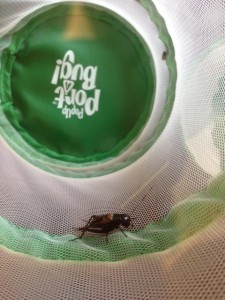
We also managed to catch a bunch of grasshoppers that we haven’t seen before. Success!The species count for Friday: 1 cricket, 1 unknown katydid, 1 two-striped grasshopper, 6 unknown grasshoppers, and 3 Eastern swordbearers. This brings our total bug count to 31!
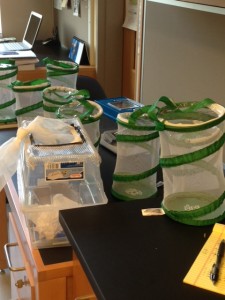
We are heading out on Wednesday to see if we can catch more crickets and some new adult male Roesel’s katydids. Should be interesting!